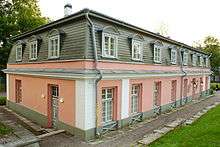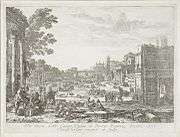Mikkel Museum
The Mikkel Museum (Estonian: Mikkeli muuseum) is a branch of the Art Museum of Estonia, located in Kadriorg park in Tallinn. It displays a collection of mainly Western art and ceramics, and Chinese porcelain, donated by art collector Johannes Mikkel in 1994.
History
The museum was founded to house the art collection of Johannes Mikkel, who in 1994 had donated his collection of foreign art to the Art Museum of Estonia. Johannes Mikkel (1907–2006) came from southern Estonia, studied various subjects (including art) at the University of Tartu and worked, after World War II, in Tallinn as a manager in several antique shops. Through his vast network he was able to assemble the collection of the present museum. In 1996, the former kitchen building (built 1754) of nearby Kadriorg Palace, where the Art Museum of Estonia's main collection of foreign art is displayed, was renovated to house the Mikkel collection.[2]
Collection
The museum contains about 600 objects. The nucleus of the collection is the large amount of Western graphic art from the 16th to 19th centuries, with a special focus on the Dutch Golden Age. The part of the collection devoted to graphics include works by Albrecht Dürer, Lucas Cranach, Rembrandt, Claude Lorrain, Adriaen van Ostade, Jacob van Ruisdael and Félicien Rops. A substantial part of the collection is also devoted to paintings from roughly the same time span; painting by Melchior d'Hondecoeter and Jean François de Troy could be mentioned, as well as a portrait from the studio of Anthony van Dyck.[3][4]
In addition to pictures, the collection also displays a set of European ceramics and Chinese porcelain. The Mikkel collection is indeed the only place in Estonia to house a representative European ceramics collection, spanning several centuries. The core of the collection are several pieces of Meissen porcelain, but also features pieces of Sèvres porcelain, Royal Copenhagen porcelain and Russian Imperial porcelain. The Chinese porcelain collection is focused on blue-and-white porcelain.[5]
Gallery of the museum
| Claude Lorrain, Campo Vaccino (1636) |
| Albrecht Dürer, Hercules Conquests the Molionites (1496-1498) |
| Jean François Janinet, Venus Disarming Amor (c. 1768) |
| Jean-Baptiste-Camille Corot, Italian Landscape (1865) |
| Adriaen van Ostade, Grace (1653) |
|
See also
References
External links
|
|---|
|
| Buildings and structures | |
|---|
|
| Precincts | |
|---|
|
| Nature and parks | |
|---|
|
| Beaches |
- Pirita Beach
- Stroomi Beach
- Kakumäe Beach
- Harku Beach
- Pikakari Beach
|
|---|
|
| Cultural settings | Museums and galleries | |
|---|
| Theatres | |
|---|
| Other | |
|---|
|
|---|
|
| Science and education | |
|---|
|
| Sports | |
|---|
|
| Transportation | |
|---|
|
| Events | |
|---|





